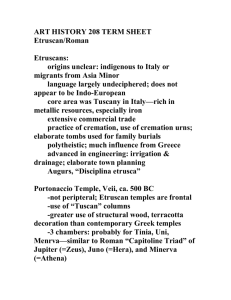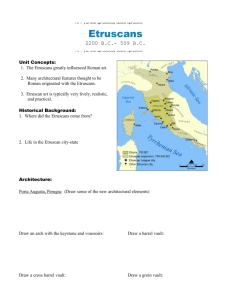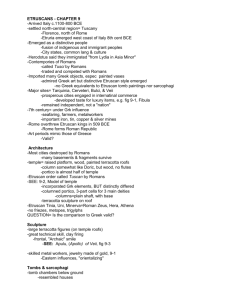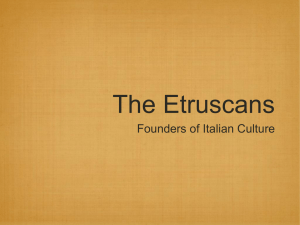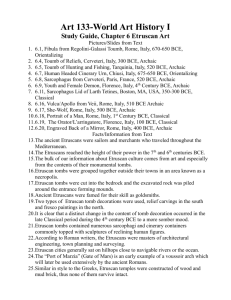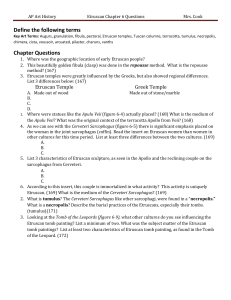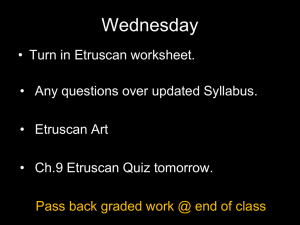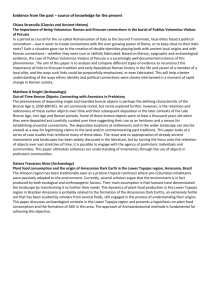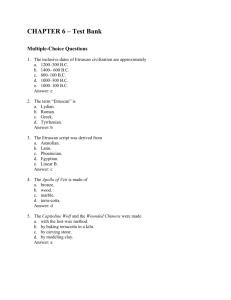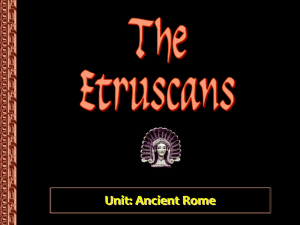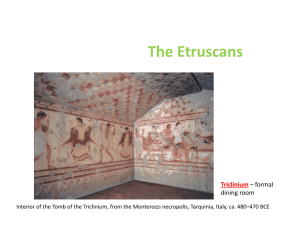Etruscan Art Notes
advertisement
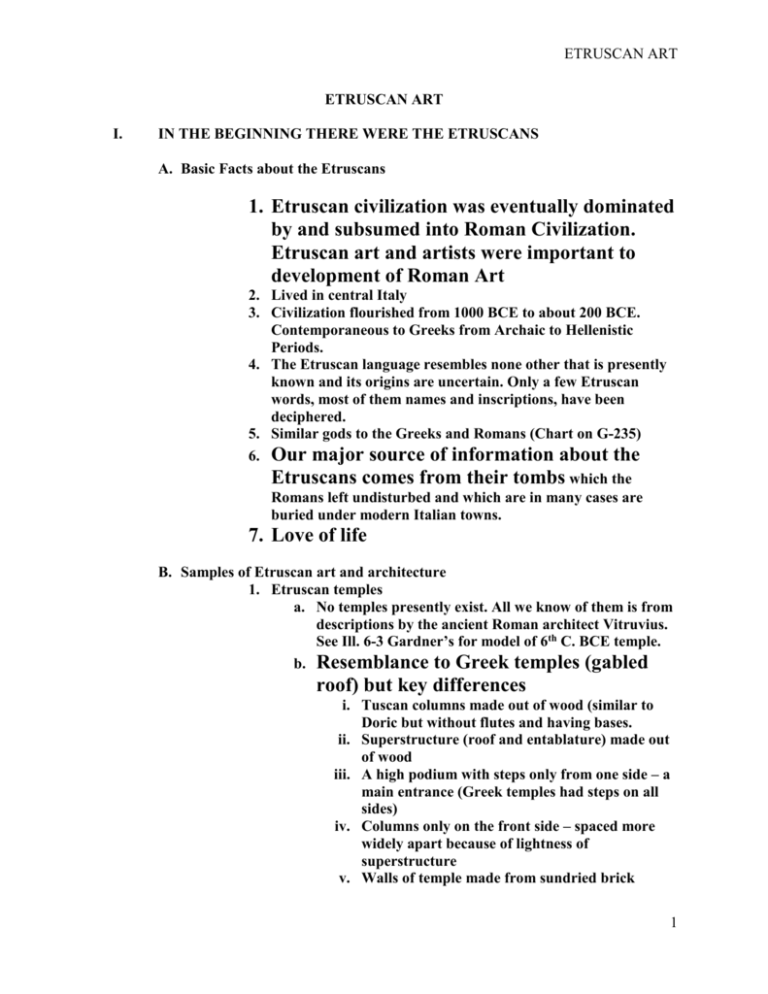
ETRUSCAN ART ETRUSCAN ART I. IN THE BEGINNING THERE WERE THE ETRUSCANS A. Basic Facts about the Etruscans 1. Etruscan civilization was eventually dominated by and subsumed into Roman Civilization. Etruscan art and artists were important to development of Roman Art 2. Lived in central Italy 3. Civilization flourished from 1000 BCE to about 200 BCE. Contemporaneous to Greeks from Archaic to Hellenistic Periods. 4. The Etruscan language resembles none other that is presently known and its origins are uncertain. Only a few Etruscan words, most of them names and inscriptions, have been deciphered. 5. Similar gods to the Greeks and Romans (Chart on G-235) 6. Our major source of information about the Etruscans comes from their tombs which the Romans left undisturbed and which are in many cases are buried under modern Italian towns. 7. Love of life B. Samples of Etruscan art and architecture 1. Etruscan temples a. No temples presently exist. All we know of them is from descriptions by the ancient Roman architect Vitruvius. See Ill. 6-3 Gardner’s for model of 6th C. BCE temple. b. Resemblance to Greek temples (gabled roof) but key differences i. Tuscan columns made out of wood (similar to Doric but without flutes and having bases. ii. Superstructure (roof and entablature) made out of wood iii. A high podium with steps only from one side – a main entrance (Greek temples had steps on all sides) iv. Columns only on the front side – spaced more widely apart because of lightness of superstructure v. Walls of temple made from sundried brick 1 ETRUSCAN ART vi. No statues in pediment – statues made out of terracotta place along the roof vii. THREE cellas, not one 2. Apulu of Veii (Ill. 6-4, Gardner’s), ca. 510 – 500 BCE a. Etruscan version of Apollo b. Would have been placed on the roof of an Etruscan temple c. Notice similarities to Archaic Greek art i. Archaic smile ii. Geometric treatment of hair, drapery d. Key differences i. Clothed – wears stylized drapery ii. Right foot forward iii. Clearly in motion iv. Swirling drapery, not hanging like Greek archaic period drapery. v. Made out of terracotta, not bronze 1. therefore needed support column which also was covered in geometric design 3. Sarcophagus of reclining couple from Cerveteri, ca. 520 BCE, Ill 6-5, Gardner’s, Good for essays about family and gender. a. Social Implications i. Etruscans cremated their dead ii. Figures represent a married couple iii. Wife and husband are given a similar status reflecting the relatively high status of women in Etruscan society 1. Shocked Greeks 2. Ate with women 3. Women owned property 4. Buried together b. Stylistic Notes i. Made out of terracotta ii. Likely found in a tumulus, Ill 6-6 Gardner’s iii. Notice lively motion of arms/hands iv. Cursory modeling of lower half of body, like a different piece – not interested? 4. Interior of the Tomb of the Reliefs, Cerveteri, 3rd C. BCE, Ill 6-8 Gardner’s a. Accommodate several generations 2 ETRUSCAN ART b. Carved out of tufa (rock) covered with stucco reliefs and painted. c. Had stone furniture and accoutrements for living carved out of living rock. 5. Tomb of the Leopards, Tarquinia, ca. 480 – 470 BCE. a. Leopards on guard above banqueters. b. Banqueters (men/dark, women/light) c. Similar pose to reclining couple sarcophagus (lively hands) d. Joyful, celebratory mood – not somber! e. Stylistically close to late Archaic Greek vase painting but more emphasis on nature 6. Tomb of Hunting and Fishing a. Joy of Life b. Gardner’s says think of Old Kingdom Tomb of Ti, painted reliefs but I think Fowling scene from tomb of Nebamun, New Kingdom, is a better match in feeling. 7. Capitoline wolf, ca. 500 – 480 BCE a. Bronze portrayal of the she-wolf that, according to Roman legend, nursed Romulus and Remus, the legendary founders of Rome b. She-wolf is totem of Rome. What is the totem of the USA? c. Romulus and Remus were added during the Renaissance d. Even though Roman themed it was created by Etruscans because Romans were not artistically developed: a commission 8. Chimera, first half of 4th C. BCE a. A triple-bodied monster, “lion before, serpent behind, she-goat in the middle.” b. Made out of bronze c. Sculpture was found in 1533 CE d. Menacing like Capitoline wolf. e. Why would Greeks NOT make an imaginary animal like this? 9. Porta Marzia, 2nd C. BCE a. Evidence of first use of arched gateways, not just openings. 3 ETRUSCAN ART 10. Sarcophagus of Lars Pulena a. Produced in Hellenistic Etruria b. A realistic human depiction but generic – not a real portrait of deceased c. Gloomy outlook of the afterlife in the lower part – the deceased is depicted being tormented by charuns – death demons d. Symptomatic of civilization in economic and political decline e. The deceased holds a scroll with his accomplishments in life 11. Aule Metele a.k.a. Arringatore (Orator), early 1st C. BCE a. Aule Metele and names of BOTH his parents are written on the hem of his garment b. Wears the short toga and high laced boots of a Roman magistrate. At this point Etruscans became Roman and Etruscan art became Roman art. c. Nicknamed the Orator because of his positioning d. Resembles Roman sculpture of the period e. Made out of bronze – Etruscan artists were still expert bronze casters f. Discovered during Renaissance 4
